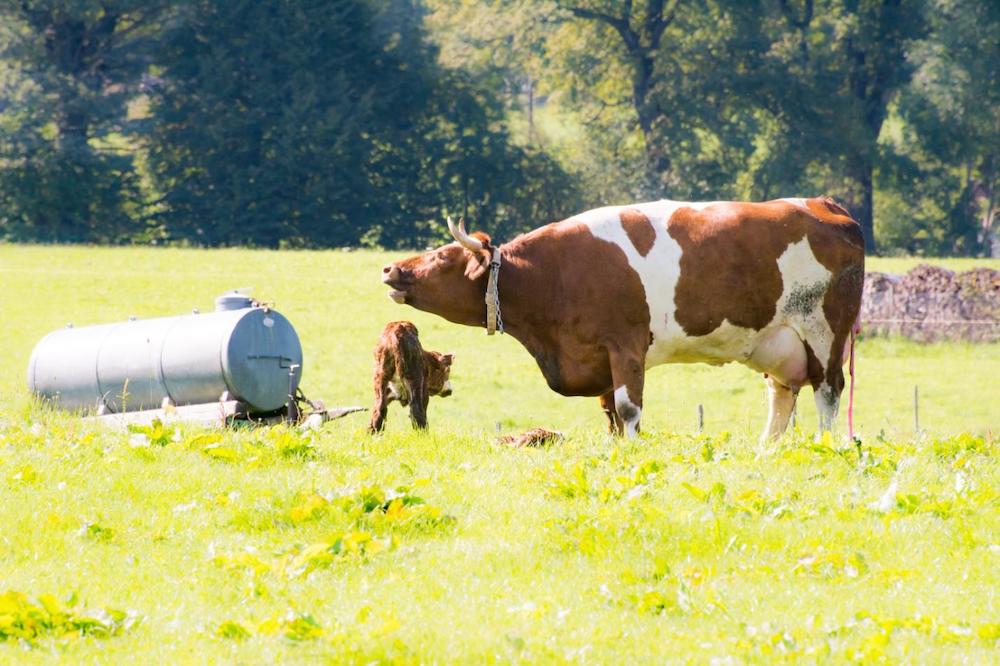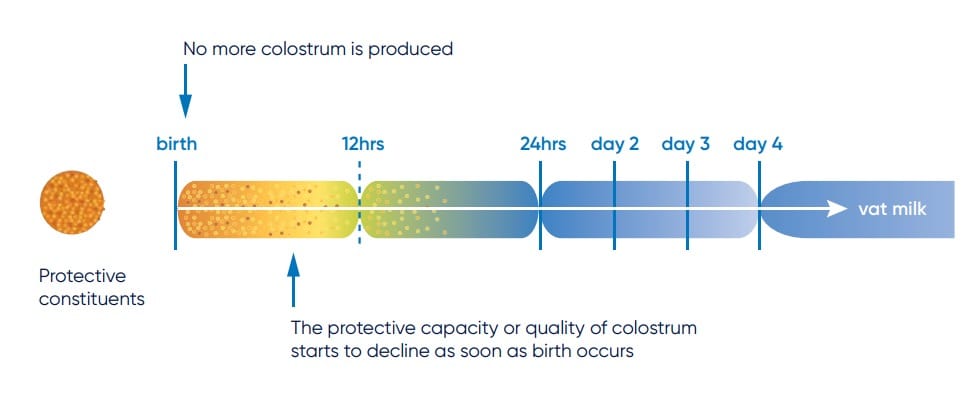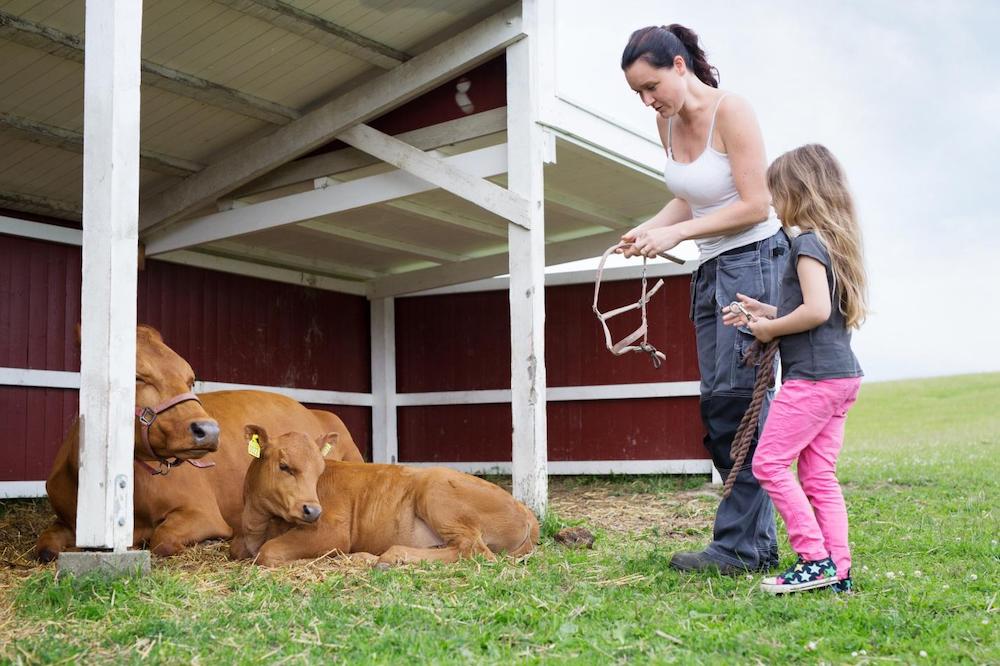This is part two of our three-part series on rearing healthy calves. In part one; we covered pre-calving care and what you can do to ensure that your dam delivers a healthy calf.
Now in part two, we’ll cover calving and what you can do in the first few months to improve the health of your calves. Next, in part three, we’ll cover weaning best practices.
The three stages of calving
You’ve taken good care of your dam, through her pre-calving phase… Today is the big day. The day of birthing (calving!)! Most cows calve without any assistance, but some, especially heifers, may need supervision.
As you know, this is simply livestock health 101.
You can split calving into three stages. In stage 1, your cow prepares to give birth. She seeks a safe place. And her milk production begins.
Next, in stage 2, usually around two to three hours before the delivery, the calf hooves begin to appear. And finally, in stage 3, the calf is delivered shortly followed by the placenta and membranes.
The first 24 hours and the importance of colostrum

Colostrum, is the first liquid a cow produces, just after delivering a calf. It's sometimes known as liquid gold because it contains very high levels of antibodies, protein and fat.
Your newly delivered calf needs all the colostrum it can get in the first 24 hours.
Why? Because inside the mother cow’s womb, the calf was always inside her foetus. So there was no risk of any infections. The calf didn't need to develop antibodies.
But the moment the calf is delivered, this changes. Now, millions of bacteria, viruses and fungi are teeming around the newly born calf.
So, the calf needs to absorb all the antibodies it can, to be healthy. And they need these antibodies quickly before the dam stops producing colostrum in about three days.

Failure to absorb sufficient antibodies from colostrum in the first 24 hours of life can increase the risk of diseases and even death for the calf. So you might need to help the weaker or fussier calves a bit, with a feeding bottle or suckler.
Make sure that you store only good quality colostrum. You can test the quality of colostrum with a simple, inexpensive Brix refractometer. A Brix score of 22% or more indicates that the colostrum has sufficient quantities of antibodies (i.e. more than 50 mg/ml).
And make sure that you store the colostrum in a refrigerator, even if it is for an hour or two. Because bacterial count in colostrum can double every twenty minutes at room temperature.
When you take it out, don't microwave or boil it, because that'll kill all the useful antibodies in it. Instead, thaw the feeding bottle in a warm water bath for a few minutes before feeding it to the calf.
How much is enough? Generally, the answer is – as much colostrum as the dam produces. But more specifically, this will depend upon the breed. For example, Holstein-Friesian calves need about 4 litres while Jersey calves need about 2 litres of colostrum in the first 24 hours.
Even after the dam stops producing colostrum, the calves will have enough antibodies in their bloodstream to fight infections, until they’re about six weeks old. After that, they begin to make their own antibodies.
Fresh and clean water
After colostrum and a clean shed, the next most important care for calves is fresh, clean water because every cell needs enough water to function well.
Calves that start early on water will start early on concentrates as well. That’s why young calves need to drink around five litres of water for every kg of dry feed that they eat. This is in addition to the milk they drink.

Also, water plays an essential role in improving digestion and rumen function. We’ll talk about this in more detail next.
Improving digestion and rumen development
As you know, your calves primarily depend only on milk and milk substitutes for the first few weeks. That’s because their stomachs can’t digest hay, concentrates or grain before the first month.
But around four to six weeks, you can help your calves develop a better digestive system. And you can help them develop bigger rumens.
All your cows have four stomachs - rumen (paunch), reticulum (honeycomb), omasum (manyplies) and abomasum (true stomach). Calves are no different.
In the first month, your calves can digest only milk because its abomasum is well developed while the rumen is underdeveloped.

The rumen chamber is what ferments and breaks down hay, grain and concentrate into more easily absorbable nutrients. So the sooner your calves develop their rumen, the sooner they’ll be able to take to your pasture and feed.
A study by researchers at Penn State University, suggests that you can accelerate rumen development in your month old calves by starting them off with small quantities of grain. This can help them develop larger and thicker walled rumens.
But starting them off on grain as early as two to four weeks can be hard on the calves. That’s why it’s probably a better idea to wean them off milk gradually with the help of starter concentrate feeds.
Consider feeding your calves with a ‘calf starter’ ration for the first two months, and from there on, switch to the ‘calf grower’ ration. Coarse starter concentrate feeds are more palatable than finely ground ones. After a few weeks in, you could slowly introduce pellets.
A typical calf ration has barley, flaked maize, peas, beet pulp, processed soya, linseed flakes, molasses, and pelleted protein balancers. That’s because a calf ration should essentially contain enough:
- Fibre – needed for rumen development.
- Protein – needed for metabolism and growth.
- Energy – needed for vital functions like walking, grazing, breathing and for growth.
- Vitamins – needed for metabolism, bone growth and immunity against diseases.
- Minerals – needed for the metabolism of carbohydrates, cartilage and bone growth, muscle functions.
So the feed rations may vary a little, as long as you ensure that your calves get enough fibre, protein, energy and nutrients.
However, different feed sources have varying levels of effect on your calves. For example, the below table from a study by Castells et al. shows how Holstein-Friesian calves respond to different feeds.

And once you’re calves are three to four months old, you can always turn them over to your pasture. Grazing high-quality swards of pasture can mean the world of difference when it comes to rearing healthy calves.
That brings us to the end of this piece. I trust that this was useful to you. Watch out for part 3 of this three-part series on rearing healthy calves. In that, we'll cover the best practices of weaning your calves.
You might also want to check out part 1, where we spoke about pre-calving care. This is all apart of our growing repository on farm animal health that we are writing for you.
Have any questions? Leave them as a comment below, and I’ll personally answer them for you.
Until we meet again, Happy Farming!
- The Dedicated Team of Pasture.io, 2020-11-19